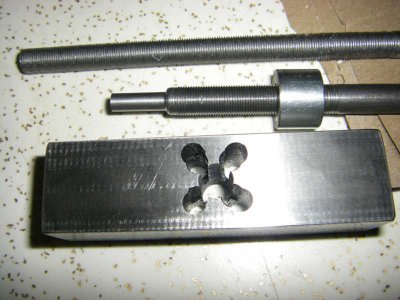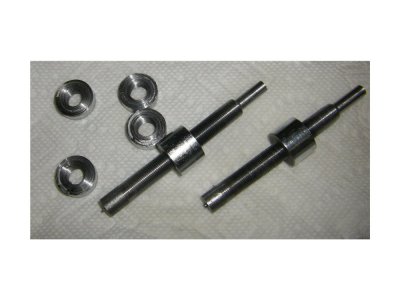- Joined
- Jan 28, 2011
- Messages
- 3,586
I have never made a threading die before. A tap, yes years ago, but never a die.
I was trying to thread a 3/8” diameter rod to make collimation bolts for my telescope build. I need about a 2” threaded section to make things work. I purchased a 3/8” X 32 TPI tap to give me a smoother and smaller change on a larger movement than if I used standard 3/8” threaded rod. I made up the adjustment nuts and was quite successful on those and parted them off.
Saturday I took some 3/8” rod and threaded a section to see how things would go. Well the threading part was not the issue, it is the quality of the thread. Really junky. I assumed that is was the rod material, likely just cold rolled stuff. I grabbed some better stuff and was not satisfied either. I looked over the cutting tool and resharpened it again. Still not any good. I also found that the thread was not matching up over a long distance, so the long nut would tighten up as it was threaded on. This I knew could be an issue and had planned for, but the nasty looking thread was the problem.
I tried the usually stuff. More lube, change lubes, check and sharpen the tool, smaller infeeds etc. The only thing that I did find for future reference is that the traversing handle for the carriage is very unbalanced. I found that I had to maintain a dragging pressure on the handle as the carriage was being feed across, otherwise I had a varing pitch as the handle would fall to the bottom, stop there for part of it's rotation and then be picked up again as the carriage caught up to it. Very much an issue that I will have to look further into.
Ok, what to do?
Sunday I took a scrap piece of air hardening steel 1” square and 4” long, and used the tap that I bought to make the nuts and made a die to cut those little pesky threads. Today I took the piece in to work and finished cutting the flukes on the mill. Heated up in the furnace at 1750 F for 60 minutes under nitrogen gas, removed and placed on a carbon block to cool prior to putting it into the oven at 450-500 degrees for about 30 minutes and turned the power off and allow to finally cool. Took it out, took it over to the surface grinder to remove the small amount of oxide and did a hardness test. Came out at 59RC. Sweet! Touched up the teeth a bit and brought it home.
I again chucked up a rod and turned the first section down to the minimum diameter to give me a lead in area and then roughed the thread to reduce the load on my little experiment. Remember this is my first ever die. I had made a total of 1 tap years ago to some success using mystery steel and Kasenite. So here I am with a partially threaded rod and a homemade die, I lube them up and start turning. Well it bites and it starts cutting and I can still turn it by hand without using any wrenches etc.
Hey this is working!
I think the results speak for themselves. The lathe cut rod is the top one. You can see, if you look closely how ragged and varying the thread and pitch is. The lower rod with the turned down section was roughed on the lathe and then I ran the die along by hand. Very nice thread. Not perfect as I can see a little imperfections here and there, likely from the first step of cutting the thread using the single point tool. I have to really look into this. On large threads I have not had this issue.
Anyways a very servicable die. A happy camper here!
Pierre

I was trying to thread a 3/8” diameter rod to make collimation bolts for my telescope build. I need about a 2” threaded section to make things work. I purchased a 3/8” X 32 TPI tap to give me a smoother and smaller change on a larger movement than if I used standard 3/8” threaded rod. I made up the adjustment nuts and was quite successful on those and parted them off.
Saturday I took some 3/8” rod and threaded a section to see how things would go. Well the threading part was not the issue, it is the quality of the thread. Really junky. I assumed that is was the rod material, likely just cold rolled stuff. I grabbed some better stuff and was not satisfied either. I looked over the cutting tool and resharpened it again. Still not any good. I also found that the thread was not matching up over a long distance, so the long nut would tighten up as it was threaded on. This I knew could be an issue and had planned for, but the nasty looking thread was the problem.
I tried the usually stuff. More lube, change lubes, check and sharpen the tool, smaller infeeds etc. The only thing that I did find for future reference is that the traversing handle for the carriage is very unbalanced. I found that I had to maintain a dragging pressure on the handle as the carriage was being feed across, otherwise I had a varing pitch as the handle would fall to the bottom, stop there for part of it's rotation and then be picked up again as the carriage caught up to it. Very much an issue that I will have to look further into.
Ok, what to do?
Sunday I took a scrap piece of air hardening steel 1” square and 4” long, and used the tap that I bought to make the nuts and made a die to cut those little pesky threads. Today I took the piece in to work and finished cutting the flukes on the mill. Heated up in the furnace at 1750 F for 60 minutes under nitrogen gas, removed and placed on a carbon block to cool prior to putting it into the oven at 450-500 degrees for about 30 minutes and turned the power off and allow to finally cool. Took it out, took it over to the surface grinder to remove the small amount of oxide and did a hardness test. Came out at 59RC. Sweet! Touched up the teeth a bit and brought it home.
I again chucked up a rod and turned the first section down to the minimum diameter to give me a lead in area and then roughed the thread to reduce the load on my little experiment. Remember this is my first ever die. I had made a total of 1 tap years ago to some success using mystery steel and Kasenite. So here I am with a partially threaded rod and a homemade die, I lube them up and start turning. Well it bites and it starts cutting and I can still turn it by hand without using any wrenches etc.
Hey this is working!
I think the results speak for themselves. The lathe cut rod is the top one. You can see, if you look closely how ragged and varying the thread and pitch is. The lower rod with the turned down section was roughed on the lathe and then I ran the die along by hand. Very nice thread. Not perfect as I can see a little imperfections here and there, likely from the first step of cutting the thread using the single point tool. I have to really look into this. On large threads I have not had this issue.
Anyways a very servicable die. A happy camper here!
Pierre

Last edited:

